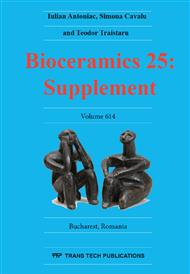[1]
Y.K. Lee, Influence of filler on the difference between the transmitted and reflected colors of experimental resin composites, Dent Mater, 24 (2008), 1243-7.
DOI: 10.1016/j.dental.2008.01.014
Google Scholar
[2]
M. Friebel, O. Pernell, H.J. Cappius, J. Helfmann, M.C. Meinke,. Simulation of color perception of layered dental composites using optical properties to evaluate the benefit of esthetic layer preparation technique, Dent. Mater., 28 (2012), 424-32.
DOI: 10.1016/j.dental.2011.11.017
Google Scholar
[3]
F.W. Billmeyer Jr & M. Saltzman, Principles of Color Technology, second ed, Wiley-Interscience, New York, 1981, pp.62-65.
DOI: 10.1002/col.5080070314
Google Scholar
[4]
Y.K. Lee. Influence of scattering/absorption characteristics on the color of resin composites, Dent Mater., 23 (2007), 124-31.
Google Scholar
[5]
T. Ikeda, Y. Murata, H. Sano, Translucency of opaque-shade resin composites, Am. J. Dent., 17(2004), 127-30.
Google Scholar
[6]
E.A. Ryan, L.E. Tam, D. McComb, Comparative translucency of esthetic composite resin restorative materials, J. Can. Dent. Assoc., 76 (2010), a84.
Google Scholar
[7]
B. Yu, Y.K. Lee, Influence of color parameters of resin composites on their translucency, Dent. Mater., 24(2008), 1236-42.
Google Scholar
[8]
Y.K. Lim, Y.K. Lee, B.S. Lim, S.H. Rhee, H.C. Yang, Influence of filler distribution on the color parameters of experimental resin composites, Dent Mater., 24 (2008), 67-73.
DOI: 10.1016/j.dental.2007.02.007
Google Scholar
[9]
B. Yu, J.S. Ahn, J.I. Lim, Y.K. Lee, Influence of TiO2 nanoparticles on the optical properties of resin composites, Dent. Mater., 25 (2009), 1142-47.
DOI: 10.1016/j.dental.2009.03.012
Google Scholar
[10]
Y. K Lee, Bin Yu, S. H. Lee, M. S. Cho, C. Y. Lee, H.N. Lim, Variation in instrument-based color coordinates of esthetic restorative materials by measurement method—A review, Dental Materials, 26 (2010), 1098-1105.
DOI: 10.1016/j.dental.2010.07.010
Google Scholar
[11]
M, Schmeling, DE Andrada MA, H.P. Maia, DE Araújo EM., Translucency of value resin composites used to replace enamel in stratified composite restoration techniques, J. Esthet. Restor. Dent., 24 (2012), 53-8.
DOI: 10.1111/j.1708-8240.2011.00419.x
Google Scholar
[12]
B. Yu, Y.K. Lee, Translucency of varied brand and shade of resin composites, Am. J. Dent., 21 (2008), 229-32.
Google Scholar
[13]
K. Yamanel, A. Caglar, M. Özcan, K. Gulsah, B. Bagis, Assessment of color parameters of composite resin shade guides using digital imaging versus colorimeter, J. Esthet. Restor. Dent., 22 (2010), 379-88.
DOI: 10.1111/j.1708-8240.2010.00370.x
Google Scholar
[14]
S. Rüttermann, C. Wandrey, W. H. Raab, R. Janda, Novel nano-particles as fillers for an experimental resin-based restorative material, Acta. Biomater., 4 (2008), 1846-53.
DOI: 10.1016/j.actbio.2008.06.006
Google Scholar
[15]
H. Naeimi Akbar, K. Moharamzadeh, D. J. Wood, R. Van Noort, Relationship between color and translucency of multishaded dental composite resins. Int J Dent, 2012: 708032.
DOI: 10.1155/2012/708032
Google Scholar
[16]
Q. Li, B.T. Xu, R. Li, Y.N. Wang, Spectrophotometric comparison of translucent composites and natural enamel, J. Dent., 38 (2010), 117-22.
Google Scholar
[17]
T. Ikeda, S.K. Sidhu, Y. Omata, M. Fujita, H. Sano, Colour and translucency of opaque-shades and body-shades of resin composites, Eur. J. Oral. Sci., 113 (2005), 170-3.
DOI: 10.1111/j.1600-0722.2005.00205.x
Google Scholar
[18]
S.B. Mitra, D. Wu, B.N. Holmes, An application of nanotechnology in advanced dental materials, J Am Dent Assoc., 134 (2003), 1382-90.
Google Scholar
[19]
J.J. Kim, H.J. Moon, B.S. Lim, Y.K. Lee, S.H. Rhee, H.C. Yang, The effect of nanofiller on the opacity of experimental composites, J. Biomed Mater Res. B Appl Biomater, 80 (2007), 332-8.
DOI: 10.1002/jbm.b.30601
Google Scholar
[20]
S.J. Kim, H.H. Son, B.H. Cho, I.B. Lee, C.M. Um, Translucency and masking ability of various opaque-shade composite resins, J. Dent., 37 (2009), 102-7.
DOI: 10.1016/j.jdent.2008.10.002
Google Scholar
[21]
B. Yu, Y. K Lee, Differences in color, translucency and fluorescence between flowable and universal resin composites, Journal of Dentistry, 36 (2008), 840–46.
DOI: 10.1016/j.jdent.2008.06.003
Google Scholar
[22]
T. Ikeda, Y. Murata, H. Sano, Translucency of opaque shade resin composites. American Journal of Dentistry, 17 (2004), 127–30.
Google Scholar
[23]
B. Yu, Y.K. Lee, Influence of color parameters of resin composites on their translucency. Dental Materials, 24 (2008), 1236–42.
DOI: 10.1016/j.dental.2008.01.016
Google Scholar
[24]
S.T. Woo, B. Yu, J.S. Ahn, Y.K. Lee, Comparison of translucency between indirect and direct resin composites, J Dent, 36 (2008), 637-42.
DOI: 10.1016/j.jdent.2008.04.012
Google Scholar
[25]
A. Arimoto, M. Nakajima, K. Hosaka, K. Nishimura, M. Ikeda, R.M. Foxton, J. Tagami, Translucency, opalescence and light transmission characteristics of light-cured resin composites, Dent Mater, 26 (2010), 1090-97.
DOI: 10.1016/j.dental.2010.07.009
Google Scholar
[26]
H. Lu, Y.K. Lee, M. Oguri, J.M. Powers, Properties of a dental resin composite with spherical inorganic filler, Operative Dentistry, 31 (2006), 734–40.
DOI: 10.2341/05-154
Google Scholar
[27]
N. Kamishima, T. Ikeda, H. Sano, Color and translucency of resin composites for layering techniques, Dental Materials, 24 (2005), 428–32.
DOI: 10.4012/dmj.24.428
Google Scholar
[28]
J. Liuyun, Li Yubao, X. Chengdong, Preparation and biological properties of a novel composite scaffold of nano-hydroxyapatite / chitosan/carboxymethyl cellulose for bone tissue engineering, Journal of Biomedical Science, 16 (2009), 65.
DOI: 10.1186/1423-0127-16-65
Google Scholar
[29]
M. Ota, S. Ando, H. Endo, Y. Ogura, M. Miyazaki, Y. Hosoya, Influence of refractive index on optical parameters of experimental resin composites, Acta Odontol Scand, 70 (2012): 362-67.
DOI: 10.3109/00016357.2011.600724
Google Scholar


